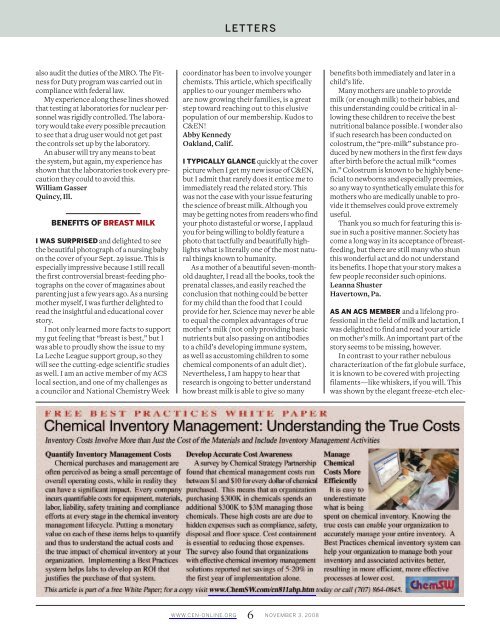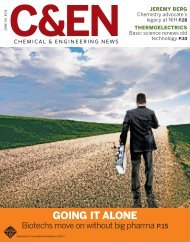Chemical & Engineering News Digital Edition ... - IMM@BUCT
Chemical & Engineering News Digital Edition ... - IMM@BUCT
Chemical & Engineering News Digital Edition ... - IMM@BUCT
Create successful ePaper yourself
Turn your PDF publications into a flip-book with our unique Google optimized e-Paper software.
LETTERS<br />
also audit the duties of the MRO. The Fitness<br />
for Duty program was carried out in<br />
compliance with federal law.<br />
My experience along these lines showed<br />
that testing at laboratories for nuclear personnel<br />
was rigidly controlled. The laboratory<br />
would take every possible precaution<br />
to see that a drug user would not get past<br />
the controls set up by the laboratory.<br />
An abuser will try any means to beat<br />
the system, but again, my experience has<br />
shown that the laboratories took every precaution<br />
they could to avoid this.<br />
William Gasser<br />
Quincy, Ill.<br />
BENEFITS OF BREAST MILK<br />
I WAS SURPRISED and delighted to see<br />
the beautiful photograph of a nursing baby<br />
on the cover of your Sept. 29 issue. This is<br />
especially impressive because I still recall<br />
the first controversial breast-feeding photographs<br />
on the cover of magazines about<br />
parenting just a few years ago. As a nursing<br />
mother myself, I was further delighted to<br />
read the insightful and educational cover<br />
story.<br />
I not only learned more facts to support<br />
my gut feeling that “breast is best,” but I<br />
was able to proudly show the issue to my<br />
La Leche League support group, so they<br />
will see the cutting-edge scientific studies<br />
as well. I am an active member of my ACS<br />
local section, and one of my challenges as<br />
a councilor and National Chemistry Week<br />
coordinator has been to involve younger<br />
chemists. This article, which specifically<br />
applies to our younger members who<br />
are now growing their families, is a great<br />
step toward reaching out to this elusive<br />
population of our membership. Kudos to<br />
C&EN!<br />
Abby Kennedy<br />
Oakland, Calif.<br />
I TYPICALLY GLANCE quickly at the cover<br />
picture when I get my new issue of C&EN,<br />
but I admit that rarely does it entice me to<br />
immediately read the related story. This<br />
was not the case with your issue featuring<br />
the science of breast milk. Although you<br />
may be getting notes from readers who find<br />
your photo distasteful or worse, I applaud<br />
you for being willing to boldly feature a<br />
photo that tactfully and beautifully highlights<br />
what is literally one of the most natural<br />
things known to humanity.<br />
As a mother of a beautiful seven-monthold<br />
daughter, I read all the books, took the<br />
prenatal classes, and easily reached the<br />
conclusion that nothing could be better<br />
for my child than the food that I could<br />
provide for her. Science may never be able<br />
to equal the complex advantages of true<br />
mother’s milk (not only providing basic<br />
nutrients but also passing on antibodies<br />
to a child’s developing immune system,<br />
as well as accustoming children to some<br />
chemical components of an adult diet).<br />
Nevertheless, I am happy to hear that<br />
research is ongoing to better understand<br />
how breast milk is able to give so many<br />
benefits both immediately and later in a<br />
child’s life.<br />
Many mothers are unable to provide<br />
milk (or enough milk) to their babies, and<br />
this understanding could be critical in allowing<br />
these children to receive the best<br />
nutritional balance possible. I wonder also<br />
if such research has been conducted on<br />
colostrum, the “pre-milk” substance produced<br />
by new mothers in the first few days<br />
after birth before the actual milk “comes<br />
in.” Colostrum is known to be highly beneficial<br />
to newborns and especially preemies,<br />
so any way to synthetically emulate this for<br />
mothers who are medically unable to provide<br />
it themselves could prove extremely<br />
useful.<br />
Thank you so much for featuring this issue<br />
in such a positive manner. Society has<br />
come a long way in its acceptance of breastfeeding,<br />
but there are still many who shun<br />
this wonderful act and do not understand<br />
its benefits. I hope that your story makes a<br />
few people reconsider such opinions.<br />
Leanna Shuster<br />
Havertown, Pa.<br />
AS AN ACS MEMBER and a lifelong professional<br />
in the field of milk and lactation, I<br />
was delighted to find and read your article<br />
on mother’s milk. An important part of the<br />
story seems to be missing, however.<br />
In contrast to your rather nebulous<br />
characterization of the fat globule surface,<br />
it is known to be covered with projecting<br />
filaments—like whiskers, if you will. This<br />
was shown by the elegant freeze-etch elec-<br />
WWW.CEN-ONLINE.ORG 6 NOVEMBER 3, 2008

















